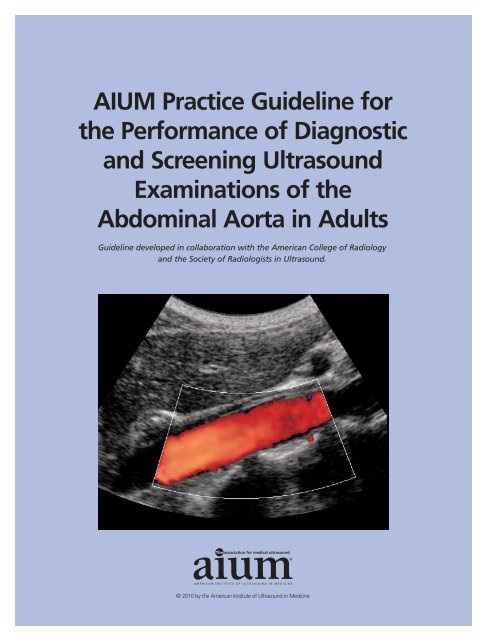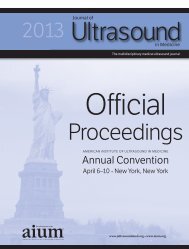Abdominal Aorta - AIUM
Abdominal Aorta - AIUM
Abdominal Aorta - AIUM
- No tags were found...
You also want an ePaper? Increase the reach of your titles
YUMPU automatically turns print PDFs into web optimized ePapers that Google loves.
<strong>AIUM</strong> Practice Guideline forthe Performance of Diagnosticand Screening UltrasoundExaminations of the<strong>Abdominal</strong> <strong>Aorta</strong> in AdultsGuideline developed in collaboration with the American College of Radiologyand the Society of Radiologists in Ultrasound.© 2010 by the American Institute of Ultrasound in Medicine
The American Institute of Ultrasound in Medicine (<strong>AIUM</strong>) is a multidisciplinaryassociation dedicated to advancing the safe and effective use of ultrasound inmedicine through professional and public education, research, development ofguidelines, and accreditation. To promote this mission, the <strong>AIUM</strong> is pleased topublish in conjunction with the American College of Radiology (ACR) and theSociety of Radiologists in Ultrasound (SRU) this <strong>AIUM</strong> Practice Guideline forthe Performance of Diagnostic and Screening Ultrasound Examinations ofthe <strong>Abdominal</strong> <strong>Aorta</strong> in Adults.The <strong>AIUM</strong> represents the entire range of clinical and basic science interests inmedical diagnostic ultrasound, and, with hundreds of volunteers, this multidisciplinaryorganization has promoted the safe and effective use of ultrasound inclinical medicine for more than 50 years. This document and others like it willcontinue to advance this mission.Practice guidelines of the <strong>AIUM</strong> are intended to provide the medical ultrasoundcommunity with guidelines for the performance and recording ofhigh-quality ultrasound examinations. The guidelines reflect what the <strong>AIUM</strong>considers the minimum criteria for a complete examination in each area butare not intended to establish a legal standard of care. <strong>AIUM</strong>-accredited practicesare expected to generally follow the guidelines with recognition thatdeviations from these guidelines will be needed in some cases, dependingon patient needs and available equipment. Practices are encouraged to gobeyond the guidelines to provide additional service and information as needed.14750 Sweitzer Ln, Suite 100Laurel, MD 20707-5906 USA800-638-5352 • 301-498-4100www.aium.orgOriginal copyright 2006; revised 2010—<strong>AIUM</strong> PRACTICE GUIDELINES—<strong>Abdominal</strong> <strong>Aorta</strong> in Adults
I. IntroductionThe clinical aspects contained in specific sections of thisguideline (Introduction, Indications/Contraindications,Specifications of the Examination, and EquipmentSpecifications) were developed collaboratively by theAmerican Institute of Ultrasound in Medicine (<strong>AIUM</strong>),the American College of Radiology (ACR), and the Societyof Radiologists in Ultrasound (SRU). Recommendationsfor physician requirements, written request for the examination,procedure documentation, and quality controlvary among the three organizations and are addressedby each separately.These guidelines are intended to assist in the performanceand interpretation of a dedicated sonographic examinationof the abdominal aorta. The examination may be performedas a diagnostic or screening study. Comprehensivepopulation screening programs have not yet been developedin the United States but do exist elsewhere in theworld. 1,2 While it is not possible to detect every abnormality,following this guideline will maximize the detection ofabnormalities of the abdominal aorta.II. Qualifications and Responsibilities ofPersonnelSee www.aium.org for <strong>AIUM</strong> Official Statements includingStandards and Guidelines for the Accreditation ofUltrasound Practices and relevant Physician TrainingGuidelines.III. Indications/ContraindicationsIndications for ultrasound of the abdominal aorta includebut are not limited to:A. Diagnostic Evaluation for an <strong>Abdominal</strong> AorticAneurysm1. Palpable or pulsatile abdominal mass.2. Unexplained lower back pain, flank pain, orabdominal pain.3. Follow-up of a previously demonstrated abdominalaortic aneurysm.4. Follow-up of patients with an abdominal aorticand/or iliac endoluminal stent graft.B. Screening Evaluation for an <strong>Abdominal</strong> AorticAneurysm1. Men 65 years or older.2. Women 65 years or older with cardiovascular riskfactors.3. Patients 50 years or older with a family historyof aortic and/or peripheral vascular aneurysmaldisease.4. Patients with a personal history of peripheralvascular aneurysmal disease.Groups with additional risk include patients with a historyof smoking, hypertension, and certain connective tissuediseases (eg, Marfan syndrome).There are no absolute contraindications to ultrasoundof the aorta. If aortic rupture or dissection is clinicallysuspected, ultrasound is usually not the examinationof choice.IV. Written Request for the ExaminationThe written or electronic request for an ultrasound examinationshould provide sufficient information to allow forthe appropriate performance and interpretation of theexamination.The request for the examination must be originated by aphysician or other appropriately licensed health careprovider or under their direction. The accompanying clinicalinformation should be provided by a physician orother appropriate health care provider familiar with thepatient’s clinical situation and should be consistent withrelevant legal and local health care facility requirements.V. Specifications of the ExaminationA. Diagnostic ExaminationThe examination includes the following, when feasible:1. <strong>Abdominal</strong> aorta:a. Longitudinal images (along the long axis ofthe vessel):i. Proximal;ii. Mid;iii. Distal.Effective March 27, 2010—<strong>AIUM</strong> PRACTICE GUIDELINES—<strong>Abdominal</strong> <strong>Aorta</strong> in Adults 1
VII. Equipment Specifications<strong>Abdominal</strong> aortic ultrasound examinations should be performedwith real-time scanners with transducers thatallow for appropriate penetration and resolution, dependingon the patient’s body habitus. Diagnostic informationshould be optimized while keeping total ultrasound exposureas low as reasonably achievable.VIII. Quality Control and Improvement,Safety, Infection Control, and PatientEducationPolicies and procedures related to quality control, patienteducation, infection control, and safety should be developedand implemented in accordance with the <strong>AIUM</strong>Standards and Guidelines for the Accreditation ofUltrasound Practices.Equipment performance monitoring should be in accordancewith the <strong>AIUM</strong> Standards and Guidelines for theAccreditation of Ultrasound Practices.IX.ALARA PrincipleThe potential benefits and risks of each examinationshould be considered. The ALARA (as low as reasonablyachievable) principle should be observed when adjustingcontrols that affect the acoustic output and by consideringtransducer dwell times. Further details on ALARA may befound in the <strong>AIUM</strong> publication Medical Ultrasound Safety,Second Edition.AcknowledgmentsThis guideline was revised by the American Institute ofUltrasound in Medicine (<strong>AIUM</strong>) in collaboration with theAmerican College of Radiology (ACR) and the Society ofRadiologists in Ultrasound (SRU) according to the processdescribed in the <strong>AIUM</strong> Clinical Standards CommitteeManual.Collaborative CommitteeACRRaymond E. Bertino, MDLincoln L. Berland, MDEdward I. Bluth, MD<strong>AIUM</strong>Lin Diacon, MD, RDMS, RPVIDavid M. Paushter, MDCarl C. Reading, MDSRUMark E. Lockhart, MD, MPHLaurence Needleman, MDHisham Tchelepi, MD<strong>AIUM</strong> Clinical Standards CommitteeDavid M. Paushter, MD, ChairLeslie Scoutt, MD, Vice ChairSusan Ackerman, MDLisa Allen, BS, RDMS, RDCS, RVTMert Ozan Bahtiyar, MDHarris L. Cohen, MDJude Crino, MDLin Diacon, MD, RDMS, RPVIJudy Estroff, MDKimberly Gregory, MD, MPHCharlotte Henningsen, MS, RT, RDMS, RVTCharles Hyde, MDChristopher Moore, MD, RDMS, RDCSOlga Rasmussen, RDMSCarl C. Reading, MDDaniel Skupski, MDJay Smith, MDJoseph Wax, MDEffective March 27, 2010—<strong>AIUM</strong> PRACTICE GUIDELINES—<strong>Abdominal</strong> <strong>Aorta</strong> in Adults 3
Comments Reconciliation CommitteeBeverly G. Coleman, MD, CochairRichard N. Taxin, MD, CochairKimberly E. Applegate, MD, MSLincoln L. Berland, MDRaymond E. Bertino, MDEdward I. Bluth, MDLin Diacon, MD, RDMS, RPVIHoward B. Fleishon, MD, MMMMary C. Frates, MDDavid I. Hammond, MDAlan D. Kaye, MDPaul A. Larson, MDDeborah Levine, MDLawrence A. Liebscher, MDMark E. Lockhart, MD, MPHLaurence Needleman, MDDavid M. Paushter, MDCarl C. Reading, MDHisham Tchelepi, MDE. Kent Yucel, MDSuggested ReadingAdditional articles that are not cited in the document butthat the committee recommends for further reading onthis topic.6. United Kingdom Small Aneurysm Trial Participants. Long-termoutcomes of immediate repair compared with surveillance ofsmall abdominal aortic aneurysms. N Engl J Med 2002; 346:1445–1452.7. Ebaugh JL, Garcia ND, Matsumura JS. Screening and surveillancefor abdominal aortic aneurysms: who needs it and when. SeminVasc Surg 2001; 14:193–199.8. Fleming C, Whitlock EP, Beil TL, Lederle FA. Screening for abdominalaortic aneurysm: a best-evidence systematic review for theUS Preventive Services Task Force. Ann Intern Med 2005;142:203–211.9. Frame PS, Fryback DG, Patterson C. Screening for abdominalaortic aneurysm in men ages 60 to 80 years: a cost-effectivenessanalysis. Ann Intern Med 1993; 119:411–416.10. Wilmink AB, Quick CR, Hubbard CS, Day NE. Effectiveness andcost of screening for abdominal aortic aneurysm: results of apopulation screening program. J Vasc Surg 2003; 38:72–77.References1. Adams DC, Tulloh BR, Galloway SW, Shaw E, Tulloh AJ, PoskittKR. Familial abdominal aortic aneurysm: prevalence and implicationsfor screening. Eur J Vasc Surg 1993; 7:709–712.2. Ashton HA, Buxton MJ, Day NE, et al. The Multicentre AneurysmScreening Study (MASS) into the effect of abdominal aorticaneurysm screening on mortality in men: a randomised controlledtrial. Lancet 2002; 360:1531–1539.3. Comstock CE, Bluth EI, Peattie RA, Schrader T, Leslie BR. Interobservervariability in ultrasonic evaluation of abdominal aorticaneurysms. J La State Med Soc 1994; 146:526–530.4. Johnston KW, Rutherford RB, Tilson MD, Shah DM, Hollier L,Stanley JC. Suggested standards for reporting on arterialaneurysms. Subcommittee on Reporting Standards for ArterialAneurysms, Ad Hoc Committee on Reporting Standards, Societyfor Vascular Surgery, and North American Chapter, InternationalSociety for Cardiovascular Surgery. J Vasc Surg 1991; 13:452–458.5. Isselbacher EM. Thoracic and abdominal aortic aneurysms.Circulation 2005; 111:816–828.4Effective March 27, 2010—<strong>AIUM</strong> PRACTICE GUIDELINES—<strong>Abdominal</strong> <strong>Aorta</strong> in Adults
















